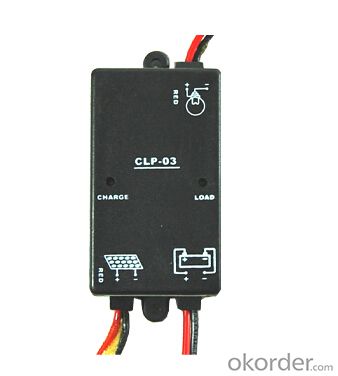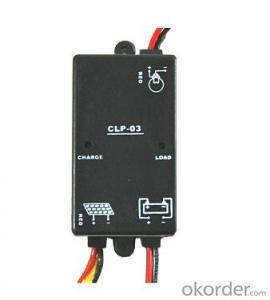Solar Streetlight Controller Model CLP03
- Loading Port:
- Shanghai
- Payment Terms:
- TT OR LC
- Min Order Qty:
- 10 unit
- Supply Capability:
- 200 unit/month
OKorder Service Pledge
OKorder Financial Service
You Might Also Like
1. Structure of Solar Streetlight Controller Model CLP03
This solar controller is designed for solar lawn lights, solar garden lights, mini solar street light, mini solar advertising light box and so on. The box of the controller is compact sealed with silicon. It is fit for 24W/12V or 36W/12V solar panels.
2. Main Features of Solar Charge Controller Model CLP03
· Smart size
· Light control function
· Temperature compensation during charging and discharging
3. Solar Charge Controller Model CLP03 Specification
Function:
1.Charge controlling: when the voltage of battery≧14.4V(with temperature compensation),controller will be shifted to floating-charge controlling, to prevent over-charging;
2.Discharge controlling: when the voltage of battery≦10.5V(with temperature compensation),controller will shut down the load,to prevent over-discharging;
3.Lighting controlling:when the voltage of solar panel≦5V(night is come on),after 30S,the load will be turned on ; when the voltage of solar panel≧5V(it is the dawn),the load will be shut down.
Rated Voltage | 12V |
Rated Charge Current | 1A or 3A |
Rated Discharge Current | 1A or 3A |
HVD (High Voltage Disconnection) | 14.4V |
Temperature Compensation | -3mV/℃/cell |
Size | 55×36×20mm |
LVD (Low Voltage Disconnection) | 10.5V |
LVR (Low Voltage Reconnection) | 12.0V |
Light Controller Mode | visibility 20m |
Temperature | -10- +40℃ |
Relative Humidity | ≦90% |
Net weight | 33g |
4. Solar Charge Controller Model CLP03 Images

5. FAQ
a) How about your company?
We are able to supply 300,000 inverters and 60,000 solar energy charge controllers per year, the products are sold toward domestic and Europe, Australia Africa and other regions in great quantities.
b) How to guarantee the quality of the products?
The company is approved by the ISO9000 quality management system with its strict product quality control. The products for exportation pass the inspection of relevant foreign nations (CE, ROHS), and get high evaluation of the customers.
c) How long can we receive the product after signing Sales Confirmation?
Generally speaking, if there is enough quantity of finished products which can meet the clients’ requirement, we can manage the delivery within three to five working days according to the instruction of the payment terms in the Sales Confirmation; if the products need some time to get ready, we will arrange thedelivery as soon as possible after the manufacture.
- Q:What is the maximum voltage drop allowed between the solar panels and the solar controller?
- The maximum voltage drop allowed between the solar panels and the solar controller depends on the specific system and its components. Generally, it is recommended to keep the voltage drop below 2% for efficient operation. However, this value may vary depending on factors such as the distance between the panels and the controller, the size of the system, and the type of wiring used. It is important to consult the manufacturer's specifications and guidelines for the solar panels and controller being used to determine the maximum acceptable voltage drop.
- Q:Can a solar controller be used with solar-powered indoor transportation hubs?
- Yes, a solar controller can be used with solar-powered indoor transportation hubs. A solar controller is a device that regulates the flow of electricity from solar panels to batteries or other energy storage systems. In the case of indoor transportation hubs powered by solar energy, a solar controller can be used to manage the energy generated by the solar panels and store it in batteries to be used during low-light conditions or when there is high demand for electricity. This ensures a reliable and consistent power supply for the indoor transportation hub, allowing it to operate efficiently and sustainably. Additionally, a solar controller can also provide important monitoring and protection functions, such as preventing overcharging or over-discharging of the batteries, optimizing energy usage, and ensuring the longevity of the solar power system. Therefore, using a solar controller in conjunction with solar panels can enhance the performance and reliability of solar-powered indoor transportation hubs.
- Q:How does a solar controller prevent damage to the solar panels from overvoltage conditions?
- A solar controller prevents damage to solar panels from overvoltage conditions by regulating the flow of electricity from the panels to the battery or grid. It acts as a bridge between the solar panels and the battery or grid, ensuring that the voltage output from the panels is within safe limits. When the solar panels generate electricity, they produce a certain voltage depending on the intensity of sunlight. However, this voltage may fluctuate due to various factors such as weather conditions and panel temperature. If the voltage exceeds the safe operating range, it can damage the panels. The solar controller constantly monitors the voltage output from the panels. If it detects that the voltage is too high, it activates a mechanism to prevent the excess voltage from reaching the panels. This mechanism can include various techniques such as pulse width modulation (PWM) or maximum power point tracking (MPPT), depending on the type of solar controller. PWM controllers regulate the voltage by rapidly switching the connection between the panels and the battery on and off. This effectively reduces the average voltage reaching the panels, preventing overvoltage conditions. MPPT controllers, on the other hand, optimize the energy conversion by adjusting the electrical load to extract maximum power from the panels without exceeding the safe voltage threshold. In both cases, the solar controller ensures that the voltage output from the panels remains within the specified range, safeguarding them from potential damage. Additionally, some advanced solar controllers may also incorporate features like temperature compensation to account for temperature variations, further enhancing the protection of the solar panels. In summary, a solar controller prevents damage to solar panels from overvoltage conditions by regulating and controlling the voltage output from the panels, ensuring it stays within safe limits through techniques like PWM or MPPT. This protection mechanism helps prolong the lifespan and efficiency of the solar panels, maximizing their performance and investment.
- Q:How does a solar controller work?
- A solar controller works by regulating the flow of electricity from the solar panels to the batteries. It monitors the battery voltage and ensures that the solar panels are charging the batteries efficiently. It also protects the batteries from overcharging or discharging, extending their lifespan.
- Q:What is the typical standby power consumption of a solar controller?
- The typical standby power consumption of a solar controller is generally very low, ranging from a few milliwatts to a few watts, depending on the specific model and features.
- Q:What is the purpose of the battery low voltage disconnect feature on a solar controller?
- The purpose of the battery low voltage disconnect feature on a solar controller is to protect the battery from being over-discharged. It automatically cuts off the power supply to prevent the battery voltage from dropping to a critically low level, which could damage the battery and reduce its lifespan. This feature ensures that the battery remains in a safe operating range and helps to prolong its overall efficiency and performance.
- Q:Can a solar controller be used with solar-powered well pumps?
- Solar-powered well pumps can indeed be used in conjunction with a solar controller. This particular device plays a crucial role in the functioning of a solar power system, as it is responsible for regulating the charging and discharging of batteries. By doing so, it ensures that the system operates efficiently and safely. When it comes to solar-powered well pumps, the solar controller takes on the additional responsibility of controlling the power flow from the solar panels to the pump. Its primary function is to prevent the batteries from becoming overcharged or drained. Furthermore, the solar controller helps optimize the pump's performance by ensuring that the power generated by the solar panels is used effectively. To enhance the overall efficiency and longevity of the system, it is highly recommended to incorporate a solar controller when using solar-powered well pumps.
- Q:Can a solar controller be used with solar-powered streetlights?
- Yes, a solar controller can be used with solar-powered streetlights. A solar controller regulates the voltage and current from the solar panels to ensure efficient charging of the batteries used in solar-powered streetlights. It helps manage the charging process and protects the batteries from overcharging or discharging.
- Q:Can a solar controller handle power fluctuations from appliances?
- Yes, a solar controller is designed to handle power fluctuations from appliances. It regulates and stabilizes the power output from solar panels, ensuring a consistent and safe supply of electricity to appliances, even during fluctuations in power generation.
- Q:Can a solar controller be used with a grid-tied solar system?
- No, a solar controller is not typically used with a grid-tied solar system. Grid-tied systems are designed to directly connect to the electrical grid, allowing excess energy to be fed back into the grid. Solar controllers, on the other hand, are commonly used in off-grid systems to regulate and optimize the charging of batteries.
1. Manufacturer Overview |
|
|---|---|
| Location | |
| Year Established | |
| Annual Output Value | |
| Main Markets | |
| Company Certifications | |
2. Manufacturer Certificates |
|
|---|---|
| a) Certification Name | |
| Range | |
| Reference | |
| Validity Period | |
3. Manufacturer Capability |
|
|---|---|
| a)Trade Capacity | |
| Nearest Port | |
| Export Percentage | |
| No.of Employees in Trade Department | |
| Language Spoken: | |
| b)Factory Information | |
| Factory Size: | |
| No. of Production Lines | |
| Contract Manufacturing | |
| Product Price Range | |
Send your message to us
Solar Streetlight Controller Model CLP03
- Loading Port:
- Shanghai
- Payment Terms:
- TT OR LC
- Min Order Qty:
- 10 unit
- Supply Capability:
- 200 unit/month
OKorder Service Pledge
OKorder Financial Service
Similar products
New products
Hot products
Hot Searches
Related keywords




























